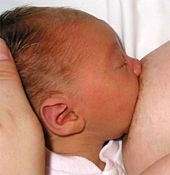beby dance
An infant (from the Latin word infans, meaning "unable to speak" or "speechless") is the very young offspring of a human or animal. When applied to humans, the term is usually considered synonymous withbaby or bairn (in Scottish English), but the latter is commonly applied to the young of any animal. When a human child learns to walk, the termtoddler may be used instead.
The term infant is typically applied to young children between the ages of 1 month and 12 months; however, definitions may vary between birth and 1 year of age, or even between birth and 2 years of age. Anewborn is an infant who is only hours, days, or up to a few weeks old. In medical contexts, newborn or neonate (from Latin, neonatus, newborn) refers to an infant in the first 28 days after birth;[1] the term applies to premature infants, postmature infants, and full term infants. Before birth, the term fetus is used. In the UK, infant is a term that can be applied to school children aged between four and seven. As a legal terminology, "infancy" continues from birth until age 18

Physical characteristics of newborn
A crying newborn, a few days after birth
A newborn's shoulders and hips are wide, the abdomen protrudes slightly, and the arms and legs are relatively long with respect to the rest of their body. In first world nations, the average total body length of newborns are 35.6–50.8 cm (14.0–20.0 in), although premature newborns may be much smaller. The Apgar score is a measure of a newborn's transition from the uterus during the first minutes after birth.
Weight
In developed countries, the average birth weight of a full-term newborn is approximately 3.4 kg (7 1⁄2 lb), and is typically in the range of 2.7–4.6 kg (6.0–10.1 lb).
Over the first 5–7 days following birth, the body weight of a term neonate decreases by 3–7%,[3] and is largely a result of the resorption and urination of the fluid that initially fills the lungs, in addition to a delay of often a few days before breastfeedingbecomes effective. After the first week, healthy term neonates should gain 10–20 grams/day.

A newborn's head is very large in proportion to the body, and the cranium is enormous relative to his or her face. While the adult human skull is about one seventh of the total body length, the newborn's is about ¼. Normal head circumference for a full-term infant is 33–36 cm at birth.[4] At birth, many regions of the newborn's skull have not yet been converted to bone, leaving "soft spots" known as fontanels. The two largest are the diamond-shaped anterior fontanel, located at the top front portion of the head, and the smaller triangular-shaped posterior fontanel, which lies at the back of the head. Later in the child's life, these bones will fuse together in a natural process. A protein called noggin is responsible for the delay in an infant's skull fusion.[5]
A newborn baby in Indonesia, with umbilical cord ready to be clamped
During labour and birth, the infant's skull changes shape to fit through the birth canal, sometimes causing the child to be born with a misshapen or elongated head. It will usually return to normal on its own within a few days or weeks. Special exercises sometimes advised by physicians may assist the process.
Hair
Some newborns have a fine, downy body hair called lanugo. It may be particularly noticeable on the back, shoulders, forehead, ears and face of premature infants. Lanugo disappears within a few weeks. Infants may be born with full heads of hair; others, particularly caucasian infants, may have very fine hair or may even be bald. Amongst fair-skinned parents, this fine hair may be blonde, even if the parents are not. The scalp may also be temporarily bruised or swollen, especially in hairless newborns, and the area around the eyes may be puffy.
Skin
Immediately after birth, a newborn's skin is often grayish to dusky blue in color. As soon as the newborn begins to breathe, usually within a minute or two, the skin's color reaches its normal tone. Newborns are wet, covered in streaks of blood, and coated with a white substance known as vernix caseosa, which is hypothesised to act as an antibacterial barrier. The newborn may also have Mongolian spots, various other birthmarks, or peeling skin, particularly on the wrists, hands, ankles, and feet.

Genitals
A newborn's genitals are enlarged and reddened, with male infants having an unusually large scrotum. The breasts may also be enlarged, even in male infants. This is caused by naturally occurring maternal hormones and is a temporary condition. Females (and even males) may actually discharge milk from their nipples (sometimes called witch's milk), and/or a bloody or milky-like substance from the vagina. In either case, this is considered normal and will disappear with time.
Umbilical cord
The umbilical cord of a newborn is bluish-white in color. After birth, the umbilical cord is normally cut, leaving a 1–2 inch stub. The umbilical stub will dry out, shrivel, darken, and spontaneously fall off within about 3 weeks. This will later become a belly-button after it heals. Occasionally, hospitals may apply triple dye to the umbilical stub to prevent infection, which may temporarily color the stub and surrounding skin purple.
Internal physiological changes at birth
A newborn infant, seconds after delivery. Amniotic fluid glistens on the child's skin.
Main article: Adaptation to extrauterine life
Upon entry into the air-breathing world, without the nutrition and oxygenation via the umbilical cord, the newborn must begin to adjust to life outside the uterus. Newborns can feel all different sensations, but respond most enthusiastically to soft stroking, cuddling and caressing. Gentle rocking back and forth often calms a crying infant, as do massages and warm baths. Newborns can be comforted by nursing, or may need to comfort themselves by sucking their thumb, or a pacifier. The need to suckle is instinctive (see suction in biology) and allows newborns to feed.
Newborn infants have unremarkable vision, being able to focus on objects only about 18 inches (46 cm) directly in front of their face. While this may not be much, it is all that is needed for the infant to look at the mother’s eyes or areola whenbreastfeeding. Depth perception does not develop until the infant is mobile. Generally, a newborn cries when wanting to feed. When a newborn is not sleeping, or feeding, or crying, he or she may spend a lot of time staring at various objects. Usually anything that is shiny, has sharp contrasting colors, or has complex patterns will catch an infant's eye. However, the newborn has a preference for looking at other human faces above all else. (see also:infant metaphysics and infant vision)
In utero, the infant can hear many internal noises, such as the sound of digestion, and the mother's heartbeat, in addition to external noises including the human voice, music and most other sounds. Therefore, though a newborn's ears may have some catarrh and fluid, he or she can hear sound from before birth. Newborns usually respond more readily to a female voice over a male voice. This may explain why people will unknowingly raise the pitch of their voice when talking to newborns (this voice change is called motherese). The sound of other human voices, especially the mother's, can have a calming or soothing effect on the newborn. Conversely, loud or sudden noises will startle and scare them. Newborns have been shown to prefer sounds that were a regular feature of their prenatal environment, for example, the theme tune of a television programme their mother watched regularly. Naturally, the rhythm of the mother's breathing and heartbeat are even more familiar to the newborn, therefore they will prefer or expect to hear it regularly for prolonged periods.

Newborns can respond to differing tastes, including sweet, sour, bitter, and salty substances, with a preference toward sweetness. It has been shown that neonates show a preference for the smell of foods that their mother ate regularly, since the amniotic fluid changes taste with different foods eaten by the mother – as does breastmilk.[citation needed]
Newborns' digestive tracts, which of course have never been used prior to birth, are filled with a greenish-black, sticky material called meconium. This has the function of standing in for fecal material and allows the intestines to develop to the point where they can process milk immediately on birth. This material is passed by the child in the first few days.



